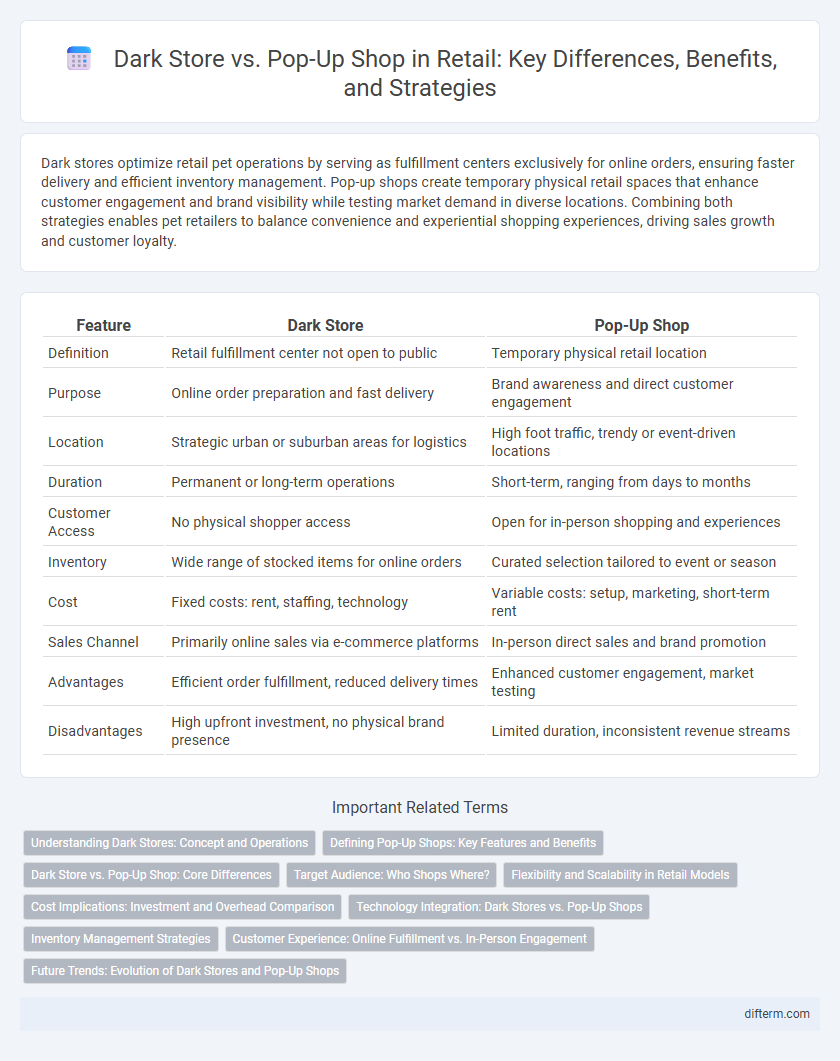Dark stores optimize retail pet operations by serving as fulfillment centers exclusively for online orders, ensuring faster delivery and efficient inventory management. Pop-up shops create temporary physical retail spaces that enhance customer engagement and brand visibility while testing market demand in diverse locations. Combining both strategies enables pet retailers to balance convenience and experiential shopping experiences, driving sales growth and customer loyalty.
Table of Comparison
| Feature | Dark Store | Pop-Up Shop |
|---|---|---|
| Definition | Retail fulfillment center not open to public | Temporary physical retail location |
| Purpose | Online order preparation and fast delivery | Brand awareness and direct customer engagement |
| Location | Strategic urban or suburban areas for logistics | High foot traffic, trendy or event-driven locations |
| Duration | Permanent or long-term operations | Short-term, ranging from days to months |
| Customer Access | No physical shopper access | Open for in-person shopping and experiences |
| Inventory | Wide range of stocked items for online orders | Curated selection tailored to event or season |
| Cost | Fixed costs: rent, staffing, technology | Variable costs: setup, marketing, short-term rent |
| Sales Channel | Primarily online sales via e-commerce platforms | In-person direct sales and brand promotion |
| Advantages | Efficient order fulfillment, reduced delivery times | Enhanced customer engagement, market testing |
| Disadvantages | High upfront investment, no physical brand presence | Limited duration, inconsistent revenue streams |
Understanding Dark Stores: Concept and Operations
Dark stores function as fulfillment centers designed exclusively for online order processing, enabling rapid delivery and efficient inventory management. These locations are strategically placed in urban areas to optimize last-mile logistics, reducing delivery times and operational costs. Unlike pop-up shops, dark stores do not serve walk-in customers but prioritize seamless e-commerce support through streamlined picking, packing, and dispatch processes.
Defining Pop-Up Shops: Key Features and Benefits
Pop-up shops are temporary retail spaces that enable brands to create immersive shopping experiences and test new markets without long-term commitments. Characterized by their short duration, high flexibility, and strategic locations, these shops drive consumer engagement and generate buzz through exclusivity and novelty. They offer cost-effective opportunities for product launches, seasonal promotions, and direct customer interaction, differentiating from dark stores that focus primarily on fulfillment and logistics.
Dark Store vs. Pop-Up Shop: Core Differences
Dark stores operate as dedicated fulfillment centers designed exclusively for online order processing, optimizing inventory management and delivery speed. Pop-up shops are temporary physical retail spaces aimed at generating immediate in-person customer engagement and brand exposure. The core difference lies in dark stores prioritizing logistics efficiency, whereas pop-up shops focus on experiential marketing and direct consumer interaction.
Target Audience: Who Shops Where?
Dark stores primarily attract online shoppers looking for speedy home delivery and convenient order fulfillment, appealing to tech-savvy urban consumers and busy professionals. Pop-up shops engage local, experience-driven customers who value immediate product access, personalized service, and unique shopping environments, often drawing brand loyalists and trend-focused shoppers. Retailers leverage dark stores to meet demand spikes with efficiency, while pop-up shops serve as strategic tools to build community presence and test new markets.
Flexibility and Scalability in Retail Models
Dark stores offer unparalleled scalability by serving as dedicated e-commerce fulfillment centers that can rapidly adjust inventory and order volume to meet fluctuating demand. Pop-up shops provide exceptional flexibility by allowing retailers to test new markets, products, and consumer preferences with minimal investment and short-term commitments. Combining dark stores with pop-up shops enables retailers to optimize both their supply chain efficiency and customer engagement strategies in highly dynamic retail environments.
Cost Implications: Investment and Overhead Comparison
Dark stores typically require higher initial investment due to warehouse-grade facilities and advanced inventory management systems, but their operating costs are optimized through centralized stock and reduced front-end staffing needs. Pop-up shops involve lower upfront expenses, relying on temporary leases and minimal inventory, yet can incur higher relative overhead with staffing, marketing, and frequent setup costs. Assessing cost implications, retailers must balance dark stores' scalable efficiency against pop-up shops' flexibility and lower fixed costs.
Technology Integration: Dark Stores vs. Pop-Up Shops
Dark stores leverage advanced inventory management systems and real-time data analytics to optimize order fulfillment and streamline delivery processes. Pop-up shops utilize mobile point-of-sale technology and augmented reality to enhance customer engagement and provide dynamic shopping experiences. Integrating IoT devices in dark stores improves automation, whereas pop-up shops focus on flexible tech solutions to adapt quickly to changing locations.
Inventory Management Strategies
Dark stores optimize inventory management by functioning as dedicated fulfillment centers, allowing retailers to maintain precise stock levels and streamline order processing for online sales. Pop-up shops rely on limited inventory tailored to short-term demand forecasts, requiring agile replenishment strategies to avoid overstock or stockouts. Efficient coordination between supply chain logistics and real-time sales data is crucial for both models to maximize inventory turnover and meet customer expectations.
Customer Experience: Online Fulfillment vs. In-Person Engagement
Dark stores enhance customer experience by streamlining online order fulfillment through dedicated inventory and faster delivery, minimizing delays and errors. Pop-up shops prioritize in-person engagement, offering tactile product interactions and personalized service that foster brand loyalty. Both models cater to evolving consumer preferences but excel in distinct aspects of convenience and experiential shopping.
Future Trends: Evolution of Dark Stores and Pop-Up Shops
Dark stores are evolving into hyper-local fulfillment centers using AI-driven inventory management to meet rising online grocery demand efficiently. Pop-up shops leverage augmented reality and data analytics to create immersive, personalized shopping experiences that boost brand engagement and capture targeted customer segments. Future retail strategies increasingly blend dark store logistics with pop-up experiential marketing to optimize convenience and consumer interaction.
dark store vs pop-up shop Infographic

 difterm.com
difterm.com